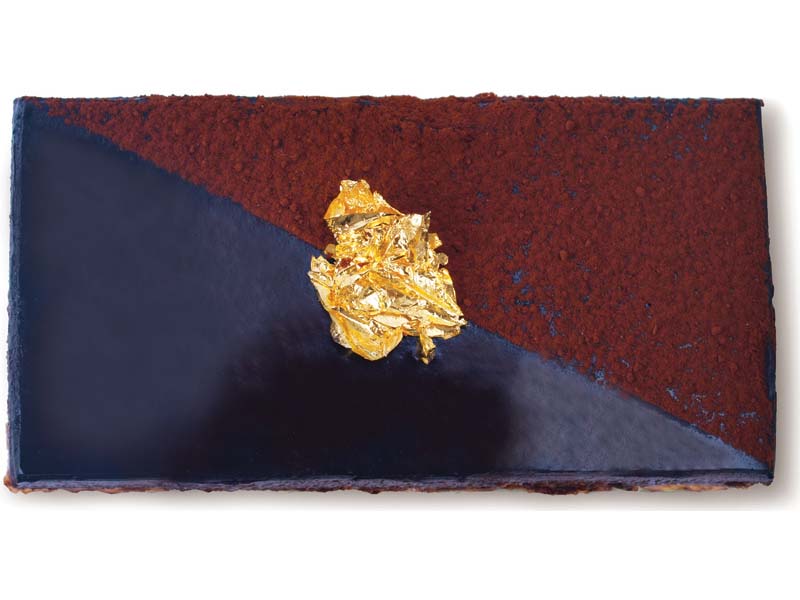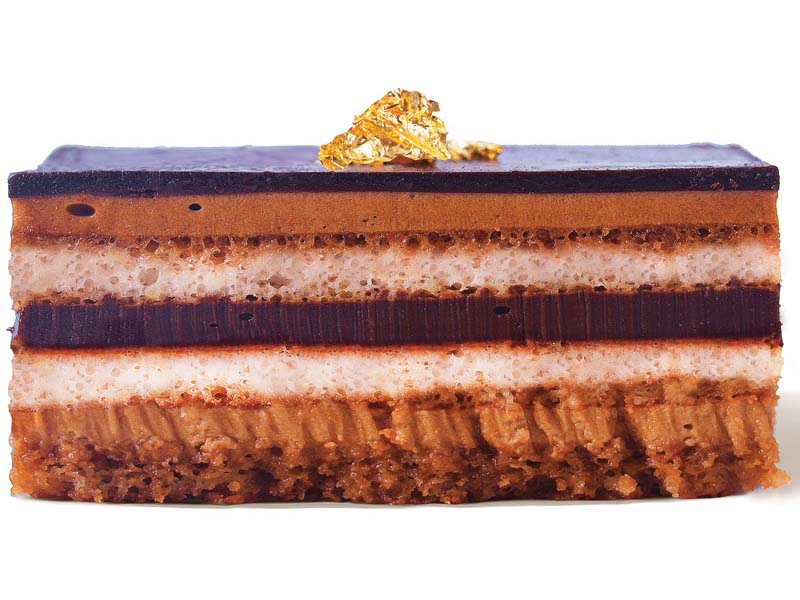

Opera Cake/ L’Opéra
Opera cake is one of the grandest of all chocolate cakes, but probably not something you will want to make very often. It requires precise planning, preparation and time-consuming work, plus you need a serious desire to make it. But if you are a true chocolate lover, you must try it at least once in your lifetime, particularly for a festive or special occasion. It will make you feel like a professional pâtissier! The story of this cake and its recipe are adapted from Paris Sweets, by Dorie Greenspan, who adapted her recipe from that of Dalloyau, the Paris-based pâtisserie/confectionery.
Anecdotes by the author (Dorie Greenspan): It is hard to say who invented the opera cake. Some say there was an opera cake sold in Paris as long ago as 1890, and some say it was created closer to 1950. But the point about which there is no controversy is that the greatest opera cake is made at Dalloyau, une grand maison that cossets the classics. There, Chef Pascal Niau makes a cake as sleek and smooth as an opera stage and as gloriously delicious as La Bohême is affectingly beautiful.
The classic opéra is a work in six acts. There are three thin layers of almond cake, each soaked in a potent coffee syrup; a layer of espresso-flavored butter cream; a layer of bittersweet chocolate ganache; and a topping of chocolate glaze. Traditionally the cake is decorated with its name written in glaze across the top and finished with a piece of shimmering gold leaf. It is obviously a rich cake, but it is surprisingly not a filling cake, and I’m convinced this is because Maestro Niau has orchestrated the cake’s elements so perfectly.
A word on size: This recipe makes a square cake that is an impressive 10 inches (25 cm) on a side. Even if this is more cake than you need, it’s best not to cut down the recipe. Instead, make the full cake, fill it, glaze it, cut it into smaller-sized cakes, and store them in your freezer.
Makes about 20 servings
THE CAKE
6 large egg whites, at room temperature
2 tablespoons (30 g) granulated sugar
2 cups (225 g) ground blanched almonds
2 cups (225 g) confectioners sugar, sifted
6 large eggs
½ cup (70 g) all-purpose flour
3 tablespoons (1 ½ oz/ 45 g) unsalted butter, melted and cooled
The Coffee Syrup
½ cup water
1/3 cup (65 g) granulated sugar
1 ½ tablespoons (7 g) instant espresso or coffee powder
The Coffee Buttercream
2 tablespoons (10 g) instant espresso or coffee powder
2 tablespoons boiling water
1cup (200 g) granulated sugar
¼ cup water
1 teaspoon pure vanilla extract
1 large egg
1 large egg yolk
1 ¾ sticks (7 oz/ 200 g) unsalted butter, at room temperature
The Ganache
8 oz (240 g) bittersweet chocolate, finely chopped
½ cup whole milk
¼ cup heavy cream
4 tablespoons (2 oz/60 g) unsalted butter, at room temperature
The Chocolate Glaze
1 stick (4 oz/115 g) unsalted butter
5 oz (150 g) bittersweet chocolate, finely chopped
- To Make the Cake: Position the racks to divide the oven into thirds and preheat the oven to 425°F (220°C). Line two 12 ½ x 15 ½ -inch (31 x 39-cm) jellyroll pans with parchment paper and brush with melted butter (this is in addition to the butter in the ingredient list)
- Working in the clean, dry bowl of a mixer fitted with the whisk attachment, beat the egg whites until they form soft peaks. Add the granulated sugar and beat until the peaks are stiff and glossy. If you do not have another mixer bowl, gently scrape the meringue into another bowl.
- In the mixer fitted with the paddle attachment, beat the almonds, confectioners sugar, and eggs on medium speed until light and voluminous, about 3 minutes. Add the flour and beat on low speed only until it disappears. Using a rubber spatula, gently fold the meringue into the almond mixture, then fold in the melted butter. Divide the batter between the pans and spread it evenly to cover the entire surface of each pan.
- Bake the cake layers for 5-7 minutes, or until they are lightly browned and just springy to the touch. Put the pan on a heatproof counter, cover each with a sheet of parchment or wax paper, turn the pans over, and unmold. Carefully peel away the parchment, then turn the parchment over and use it to cover the cakes. Let the cakes cool to room temperature. (The cakes can be made up to 1 day ahead, wrapped, and kept at room temperature.)
- To Make the Syrup: Stir the water, sugar and coffee together in a small saucepan and bring to a boil. Remove from heat and cool. (The syrup can be covered and refrigerated for up to 1 week.)
- To Make the Buttercream: Make a coffee extract by dissolving the instant espresso in the boiling water; set aside.
- Bring the sugar and water to a boil in a small saucepan, stirring just until the sugar dissolves. Continue to cook without stirring until the syrup reaches 255°F (124°C), as measured on a candy or instant-read thermometer; pull the pan from the heat. While the syrup is heating, put the full egg and the yolk in the bowl of a mixer fitted with whisk attachment and beat until pale and foamy.
- When the sugar syrup is at temperature, reduce the mixer speed to low and slowly pour in the syrup down the side of the bowl, doing your best to avoid the spinning whisk. Inevitably, some syrup will spin onto the sides of the bowl—don’t try to stir the spatters into the eggs. Raise the speed to medium high and continue to beat until the eggs are thick, satiny and at room temperature, about 5 minutes.
- Working with a rubber spatula, beat the butter until it is soft and creamy but not oily. With the mixer on medium speed, steadily add the butter in 2-tablespoon (30-g) chunks. When all the butter has been added, raise the speed to high and beat until the buttercream is thickened and satiny. Beat in the coffee extract and vanilla. Chill the buttercream, stirring frequently, until it is firm enough to be spread and stay where it is spread when topped with a layer of cake, about 20 minutes. (The buttercream can be packed airtight and refrigerated for 4 days or frozen for up to 1 month; bring it to room temperature before using, then beat to smooth it.)
- To Make the Ganache: Put the chocolate in a medium bowl and keep it nearby. Bring the milk and cream to hot but not a boil, pour it over the chocolate, and wait 30 seconds, then stir gently until the ganache is smooth and glossy.
- Beat the butter until smooth and creamy, then stir into the ganache in two to three additions. Refrigerate the ganache, stirring every 5 minutes, until it thickens and is spreadable, about 20 minutes. (The ganache can be packed airtight and refrigerated for up to 3 days or frozen for up to 1 month; bring to room temperature before using.)
- To Assemble the Cake: Line a baking sheet with parchment or wax paper. Working with one sheet of cake at a time, cut and trim each one so that you have two pieces from one sheet of the cake: one 10-inch (25-cm) square and one 10 x 5-inch (25 x 12.5-cm) rectangle. Place one square of cake on the baking sheet and moisten the layer with coffee syrup. Spread about 3/4 of the coffee buttercream evenly over the cake. (If the buttercream is soft, put the cake in the freezer for 10 minutes before proceeding.) Top with the two rectangular pieces of cake, placing them side by side to form a square; moisten with syrup. Spread the ganache over the surface, top with the last 10 x 10-inch cake layer, and moisten with syrup. Chill the cake in the freezer for about 10 minutes.
- Cover the top of the cake with a thin layer of coffee buttercream. (This is to smooth the top and ready it for glaze—so go easy.) Refrigerate the cake for at least 1 hour or for up to 6 hours; it should be cold when you pour over the glaze. Or, if you’re in a hurry, pop the cake into the freezer for about 20 minutes, then continue.
- To Glaze the Cake: Bring the butter to a boil in a small saucepan. Remove the pan from the heat and clarify the butter by spooning off the top foam and pouring the clear yellow butter into a small bowl; discard the milky residue at the bottom of the pan. Melt the chocolate in a bowl set over—not touching—simmering water, then stir in the clarified butter.
- Lift the chilled cake off the parchment-lined pan and place it on a rack. Put the rack on the parchment-lined pan and pour the glaze over the cake, using a long offset spatula to help smooth it evenly across the top. Slide the cake into the refrigerator to set the glaze and chill the cake; it should be served slightly chilled. At serving time, using a long thin knife that you dip in hot water and wipe dry between each cut, carefully trim a thin slice from the sides of the cake so that the drips of glaze are removed and layers revealed.
Keeping: Each element of the cake can be made ahead, as can the assembled cake. The cake should be kept in the refrigerator, away from foods with strong odors, for 1 day, or you can freeze it, wrap it airtight once it is frozen, and then keep it frozen for up to 1 month; defrost, still wrapped, overnight in the refrigerator.
